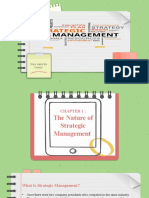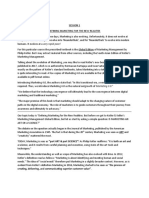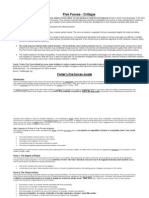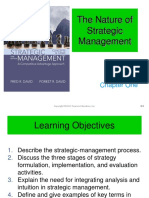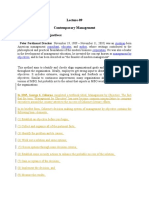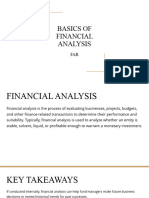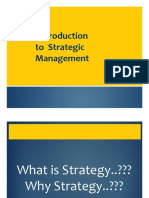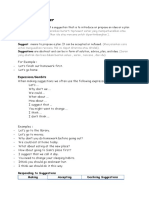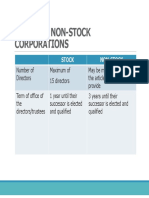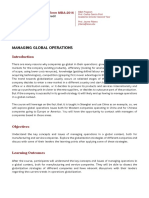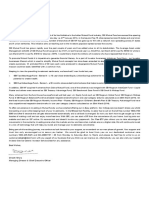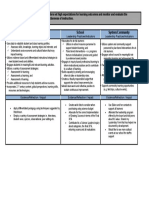Lecture 1: Introduction to Strategic Management
Lecture Objectives
By the end of this lecture, students should be able to:
1.Explain the functions of management 2.Define and explain strategy and strategic management 3.Explain why strategic management is important 4.Explain the strategic management process 5.Describe the levels of organizational strategies 6.Discuss the misconceptions about strategy and strategic management
�If you dont know where youre going, youre liable to wind up someplace else!
-- Yogi Berra
�Plans are nothing; planning is everything!
-- Dwight D. Eisenhower
�What do we mean by strategy?
Strategy is grounded in the array of competitive moves and business approaches management depends on to produce successful performance. Strategy is managements game plan for strengthening the organizations position, pleasing customers, and achieving performance targets.
�Without a strategy, managers have:
No thought-out course to follow No roadmap to manage by No action program to produce the intended result
�Whats Strategy?
Strategy is managements overall plan and actions for deploying resources and skills taking into consideration opportunities and threats in the environment
to achieve its mission, vision and objectives to establish a favorable competitive position.
Strategy involves:
An organizations goals A series of related decisions & actions Takes into account key internal strengths & weaknesses and external opportunities threats Analysis, communication, coordination, & action
�Good strategy and good strategy execution are the most trustworthy signs of good management.
�Three Fundamental Strategic Questions Where are we currently? Where do we want to be in the future? How will we get there?
�Strategic planning is a disciplined effort to produce fundamental decisions and actions that shape and guide what an organization is, what it does, and why it does it.
�Benefits of Strategic Planning
Increased effectiveness Increased efficiency Improved understanding and better learning Better decision making Enhanced organizational capabilities Improved communications and public relations Increased political support
�What does a companys strategy consist of?
Company strategies concern:
How to satisfy customers
Broad or narrow product line? Amount of customer service provided?
How to grow the business
Concentrate on a single business strategy? Diversify into related or unrelated industries?
� How to respond to changing industry and market conditions How best to capitalize on new opportunities How to manage each functional piece of the business How to achieve strategic and financial objectives
�Strategic Competitiveness
Achieved when a firm successfully formulates and implements a value-creating strategy
Sustained Competitive Advantage
Occurs when a firm develops a strategy that competitors are not simultaneously implementing Provides benefits which current and potential competitors are unable to duplicate
Above-Average Returns
Returns in excess of what an investor expects to earn from other investments with similar risk
�21st Century Competitive Landscape
Fundamental nature of competition is changing
Rapid technological changes Rapid technology diffusions Dramatic changes in information and communication technologies
The pace of change is relentless.... and increasing Traditional industry boundaries are blurring, such as...
Computers Telecommunications
Increasing importance of knowledge
�21st Century Competitive Landscape
The global economy is changing
People, goods, services and ideas move freely across geographic boundaries New opportunities emerge in multiple global markets Markets and industries become more internationalized
Traditional sources of competitive advantage no longer guarantee success New keys to success include:
Flexibility Innovation Speed Integration
�Stakeholders :
Groups who are affected by a firms performance and who have claims on its wealth
The firm must maintain performance at an adequate level in order to maintain the participation of key stakeholders
Capital Market
Firm
Product Market Product Market
Stock market/Investor Debt suppliers/Banks
Organizational Organizational
Primary Customers Suppliers
Employees Managers Non-Managers
� Focuses on how managers formulate and implement, and evaluate strategies aimed at developing and maintaining competitive advantage:
the reason some firms enjoy higher levels of performance than their rivals or competitors.
What is Strategic Management?
Strategic management is therefore concerned with overall PLOC Four aspects that set strategic management apart: Big picture view of an
Interdisciplinary External focus Internal focus Future directions
organization influenced by its external environment
�Strategic Managements Uniqueness
Field of Study
Macroeconomics Microeconomics Strategic Management Finance Marketing Org. Behavior Human Resource Mgmt. Operations Mgmt.
Level of Analysis
The economy Industries & markets Firms & businesses Investment Projects Products & services Individuals & Groups Tasks & Structure Plants
�Importance of Strategic Management
Gives every employee a role to play in making the firm successful
Applies to all professional employees, not just those in management Allows decision-making, allocation of resources and management of people to be based on a firms strategic plan Success as a manager (as measured by your promotion, job security, and pay increases) is often determined by your efforts & departments contribution to overall organizations success Research suggest that successful companies use strategic management concepts & techniques Success evolves from knowing what youre doing and often implies having a strategic plan
Makes a difference in performance levels
�Importance of Strategic Management
Provides systematic approach to uncertainties that organizations face
Competitive & global environment are dynamic (changing) Change, whether significant of minor, must be recognized and analyzed, & dealt with Strategic management allows for the analysis of the situation (identifying the sources of change in environment)
Coordinates and focuses employees to achieve organizations goals
Allows for team effort which is coordinated for firm success Allows for development of a plan, communication, coordination, & cooperation among diverse depts & functions
�Strategic Management Process
Establishing a mission, vision and objectives Environmental Analysis Internal Analysis Strategy Formulation Strategy Implementation Strategic Control and Performance Evaluation
�The Strategic Management Process
Internal Analysis
Mission, Vision & Objectives Environ. Analysis
Strategy Formulation
Strategy Implementation
Strategic Eval. & Control
�Mission, Vision & Objectives
A companys mission is a statement of
the basic purpose or reason for its existence its values (role to stakeholders - customers, employees, society, etc.).
The vision goes beyond the mission statement
clarifies the long-term direction of the company (where the company is going)
�Importance of Mission
Benefits from a strong mission
Unanimity of Purpose
Resource Allocation
Mission
Organizational Climate Focal point for work structure
�Effective Missions
Broad in scope Broad in scope Generate strategic Generate strategic alternatives alternatives Not overly specific Not overly specific Reconciles interests among Reconciles interests among diverse stakeholders diverse stakeholders Finely balanced between Finely balanced between specificity & generality specificity & generality
�Effective Missions
Arouse positive feelings & Arouse positive feelings & emotions emotions Motivate readers to action Motivate readers to action Generate favorable Generate favorable impression of the firm impression of the firm
�Effective Missions
Reflect future growth Reflect future growth Provide criteria for strategy Provide criteria for strategy selection selection Basis for generating & Basis for generating & evaluating strategic options evaluating strategic options Are dynamic in nature Are dynamic in nature
� Objectives are yardsticks for tracking a companys performance or end result.
Financial performance objectives (e.g., ROA, ROI, ROE, Dividend growth, Stock price, etc.). Strategic performance objectives (e.g., market share, growth, innovation leader, customer service, community & environmental responsibility, etc.)
Mission, Vision & Objectives
�Examples of Mission & Vision
Southwest Airlines:
Mission: To provide high quality service at a lower price in the airline industry. Vision: Opening air travel to a wider group of leisure travelers while infusing the organization with a sense of fun.
Apple Computer:
Mission: To bring the best personal computing products and support to consumers around the world. Vision: One person, one computer.
�Financial & Strategic Objectives
GE
Financial: To achieve an average of 10 inventory turns and a corporate operation profits margin of 16% by 2010. Strategic: To become most competitive enterprise in the world by being #1 or #2 in market share in every business the company is in.
�Environmental Analysis
Involves the evaluation of the business environment of the organization.
All external influences that impact a companys decision and performance.
Environment of firm classified by proximity into (1) Macro-environment; and (2) Micro-environment or task
�Environmental Analysis
The macro-environment consists of
The international/national economy; changes in demographic structures; social and political trends; technology; and the natural environment.
The micro-environment consists of
The industry environment such as competitors, suppliers, customers; unions and employees; owners and shareholders, etc.
�Internal Analysis
Involves the evaluation of the inventory of the firms resources and capabilities. Resources/Capabilities can be classified as:
Tangible resources: Financial or physical assets Intangible resources: brand name, reputation (product & firm), organizational culture, etc.
�Strategy Formulation
The strategy formulation process
involves designing a course of action for addressing strategic issues facing the firm after going through the external and internal evaluation processes.
Actual strategy of a company involves:
Planned or Intended Actions (Deliberate & purposeful actions). Reactive or Emergent Actions (Asneed reactions to unanticipated events
�Strategy Formulation
Strategy formulation is concerned with the following parts of a company:
Corporate (whole company) -Corporate strategies: Deals with businesses company wants to be in & how to manage those businesses Businesses -- Competitive strategies: How to compete in specific business or industry Functional areas -- Functional strategies: short goal-directed
�Levels of Strategic Management
�Key Question for Each Level
Corporate Strategy what business(es) should the organization be in? Business Strategy how should the organization compete? Functional Strategy how should the organizations resources be best employed to support business strategy?
�Strategy Implementation
Strategy implementation is the process of putting a companys various strategies into action
development of programs, policies, budgets & procedures.
It can take several months to years to complete. Most difficult part of the strategy process. The job of implementing strategy involves managers at all levels
�Strategic Control & Evaluation
Process by which desired outcomes (mission, vision, & objectives) are compared with realized outcomes to determine if there are gaps. Initiate corrective actions by monitoring changes in environment - competitor actions, new market
�Misconceptions about Strategy & Strategic Management
Strategy & strategic planning are dead
Every organization needs the focus and direction provided by its strategies and the strategic management process
Strategy is strictly for top management
Top management play a crucial role, but everyone in the organization has a part to play.
Strategy is about planning
Strategic management process shows
�Misconceptions about Strategy & Strategic Management
Strategy is stable and constant
Organizations compete in dynamic environments. Flexibility and change needed to respond to environmental opportunities & threats, & strength and weaknesses
Strategic management outlines ultimate destination & route
It establishes a systematic approach to analyzing relevant information & using it to design, implement, & evaluate









